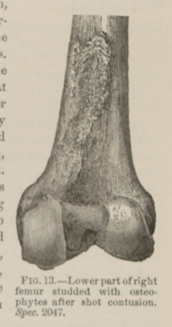Title: Dyer, G. A.
Source text: The Medical and Surgical History of the War of the Rebellion. (1861-65.), Part 3, Volume 2 (Washington, DC: Government Printing Office, 1883), 31.
Civil War Washington ID: med.d2e1582
TEI/XML: med.d2e1582.xml
CASE 67.—Sergeant G. A. Dyer, Co. G, 6th Maine, aged 21 years, was wounded at Rappahannock Station, November 7, 1863, and was admitted to Armory Square Hospital, Washington, two days afterwards. Surgeon D. W. Bliss, U. S. V., reported: "A minié ball entered four inches below and in line with the trochanter major of the right thigh, took a downward and inward course, and could not be found on admission to the hospital. On November 29th, the missile was extracted from the popliteal space; suppuration continued free and of good character. Two weeks subsequent to the extraction of the ball a bit of woolen cloth came from the lower wound. December 10th, patient was allowed to get up and move about, using crutches. December 25th, knee joint became painful and continued to swell from this date. Under iodine the swelling subsided to a considerable extent, but the pain continued; suppuration still free and at times thin and poor in character. On February 1, 1864, synovial fluid was observed from the upper point in the discharge; pain in knee joint still considerable at night, and leg enlarged. On February 19th, the thigh was amputated above the condyles by flap operation; four arteries tied; loss of blood small; patient in fair condition constitutionally. On opening the knee joint after the operation, erosion of the cartilages was discovered, and an abscess below the knee joint communicating with it. February 22d, patient doing well." The specimen represented in the adjacent cut (FIG. 13) was contributed by Surgeon Bliss, and consists of the bones of the knee of the amputated limb, showing a slight deposit of callus on the posterior aspect of the shaft, apparently due to the irritation set up by contact with the ball in position. The patient was discharged from service April 18, 1864, and pensioned, and subsequently furnished with an artificial limb. In his application for commutation, dated 1870, he described the stump as being in a sound condition. The pensioner was paid June 4, 1876. In the cut only a portion of the specimen, which consists of the four bones entering into the articulation, is represented. The amputation was done at the middle of the femur, and not through the lower third as represented in the cut.
